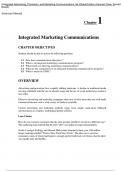(Integrated Advertising, Promotion, and Marketing Communications, 8e (Global Edition) Kenneth Clow, Donald
Baack)
(Instructor Manual)
Chapter 1
Integrated Marketing Communications
CHAPTER OBJECTIVES
Students should be able to answer the following questions:
1.1 How does communication take place?
1.2 What is an integrated marketing communications program?
1.3 What trends are affecting marketing communications?
1.4 What are the components of an integrated marketing communications program?
1.5 What is meant by GIMC?
OVERVIEW
Advertising and promotion face a rapidly shifting landscape. A decline in traditional media
viewing combined with the rise in internet usage and the use of social media have created a
new order.
Effective advertising and marketing campaigns often now involve more than one well-made
commercial because such a wide variety of media is available.
Current advertising and marketing methods range from simple stand-alone billboard
advertisements to complex, multilingual global websites.
Lean Cuisine
How do you convince consumers that the same product should be viewed in a different way?
The marketing team realized that the term “diet” was fading in usage and popularity.
Nestle, ConAgra, Kellogg, and General Mills jointly launched a three-year, $30 million
image campaign entitled “Frozen. How Fresh Stays Fresh.” The idea was to convince
consumers, many of whom had begun to strongly prefer fresh food over frozen, that the latter
was equally tasty and healthy.
Copyright © 2018 Pearson Education Ltd. Page 1-1
,Every element of this new approach sought to generate a change in consumer perceptions of
a longstanding product, noting that in FDA standards the word “lean” means food items
cannot contain more than 10 grams of fat.
Questions for Students:
1. What do you think of when you hear the term “diet” food? Will these
companies be able to change your perception?
2. Did you see this campaign? What was your reaction?
3. Do you think using social media will work in this instance? Why or why
not?
This chapter explains the nature of an integrated advertising and marketing communications
program.
First, communication processes are described. Understanding how communication works
builds the foundation for an integrated marketing program.
Also, the trends affecting marketing communications are noted.
Next, an integrated marketing communications program is described.
Finally, the integrated marketing communications process is applied to global or international
operations, creating a globally integrated marketing communications (GIMC) program.
Objective 1.1: How does communication take place?
The Nature of Communication
Communication is defined as transmitting, receiving, and processing information. The parts
of a communications model are displayed in Figure 1.1. Components that should be
discussed include:
• Sender—the person(s) attempting to deliver a message or idea
• Encoding processes—the verbal (words, sounds) and nonverbal (gestures, facial
expression, posture) cues that the sender utilizes in dispatching the message
• Transmission device—all of the items that carry the message from the sender to
the receiver
• Decoding—takes place when the receiver employs any set of his or her senses
(hearing, seeing, feeling, etc.) in the attempt to capture the message
• Receiver—the intended audience for a message
Copyright © 2018 Pearson Education Ltd. Page 1-2
, • Feedback—information the sender obtains from the receiver regarding the
receiver’s perception or interpretation of a message
• Noise—anything that distorts or disrupts a message
Figure 1.1 A Model of Communication
A message, from a company such as Chick-fil-A, is being prepared by the Sender.
Encoding processes include all of the verbal and nonverbal cues that are part of the
marketing message.
Messages travel to audiences via various transmission devices, such as a television,
billboard, Sunday paper with a coupon, or a letter to the purchasing agent of a large retail
store.
Decoding occurs when the receiver’s (consumer’s) senses are touched in some way by the
message.
Feedback occurs through inquiries, trips to the store, and purchases.
Noise is all of the factors that prevent the consumer from seeing the message. A classic
example is clutter, which exists when consumers are exposed to hundreds of marketing
messages per day and most are tuned out (see Figure 1.2)
Figure 1.2 Displays examples of communication noise that affect television.
Question for Students: Can you think of additional examples of noise in advertising
or marketing communications?
Objective 1.2: What is an integrated marketing communications program?
Integrated Marketing Communications
Integrated marketing communications (IMC) is the coordination and integration of all
marketing communication tools, avenues, and sources in a company into a seamless program
designed to maximize the impact on customers and other stakeholders.
The program should cover all of a firm’s business-to-business, market channel, customer-
focused, and internally directed communications.
The marketing mix consists of
• Products
Copyright © 2018 Pearson Education Ltd. Page 1-3
, • Pricing systems
• Distribution systems
• Promotional programs
The promotions mix consists of
• Advertising
• Sales promotions (including consumer and trade promotions)
• Personal selling activities
The IMC promotions mix also includes
• Database marketing
• Direct response marketing
• Online marketing
• Social media
• Guerilla marketing
• Alternative marketing
• Public relations programs
Figure 1.3 Displays all of these elements.
Figure 1.4 Lists the steps required to complete a marketing plan.
1. Situational analysis (examining problems and opportunities in the organization’s
external environment and strengths and weaknesses in the firm itself)
2. Defining marketing objectives (sales, market share, competitive position, and
customer actions desired)
3. Budget preparation
4. Finalizing marketing strategies and tactics
5. Evaluation of performance
Objective 1.3: What trends are affecting marketing communications?
Emerging Trends in Marketing Communications
Figure 1.5 Illustrates current trends affecting marketing communications
Emphasis on Accountability and Measurable Results
Advertising agencies are expected to produce tangible outcomes. Promotional dollars must
be spent carefully.
Copyright © 2018 Pearson Education Ltd. Page 1-4




